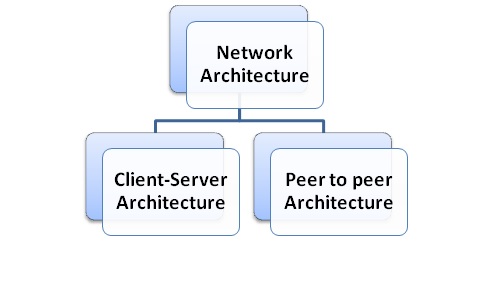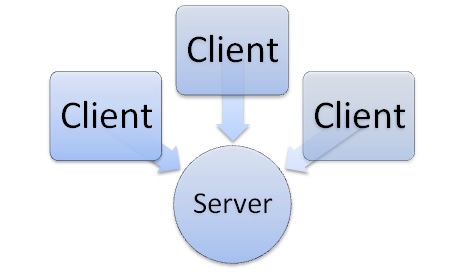
Today we are going to tell you about Client Server network architecture in this article, what and how many types of network architecture as Client Server are there along with their advantages and disadvantages.
What is Network Architecture?
Before the construction of any object, its structure is prepared, in the same way its layout is made before preparing the format of Networking, which we know as
Network Architecture.
In this, it is decided that what kind of hardware and software is to be used for communication, and which Transmission Protocol is to be included.
Before knowing about the type of Network Architecture, you should also know about some other information related to it which is-
Host –
Any device that is connected to any kind of network is called Host, like our Mobile or Computer.
Client –
The host that requests for any kind of data or services is called Client. Clint is a computer system, which accesses the service on other computers through any kind of network.
Server –
This is a host that provides any kind of online data or services to us, it is called a server. Server is the most important thing for any network.
Peer –
This is such a host, which provides data and service as well as requests, is called Peer.
How many types of Network Architecture are there?
There are actually three types of network architecture.
- Peer to Peer Architecture
- Client Server Architecture

Types of Network architecture
A] What is Peer to Peer Architecture?
In this network architecture, the host can request for any kind of data and service, and can also provide service.
It allows users to share resources and files located on their computers to access shared resources found on other computers. However, they do not have a file server or a centralized management source.
- In this network, all computers are considered equal, they all have the same abilities to use the resources available on the network.
- These networks are designed primarily for small to medium local area networks.
- In this network, there are no dedicated servers or hierarchy among the computers.
Use of Peer to Peer networks are good for environment where:
- fewer than 10 users.
- users are all located in the same general area.
- security is not an issue.
- The organization and the network will have limited growth future.
Advantages:
Easy set up is easy and have at lower cost.
Requirement for No extra investment in server Hardware or Software.
No requirement for network administrator.
Ability of users to control resources sharing.
The user is not dependent on other computer for its operation.
Disadvantages:
Their is Lack of Centralization.
Users are supposed to manage their own computers.
B] What is Client Service Architecture?
Clients send requests to the server for any kind of data and service, after that the server responds to any client, because there is a server in it, and the rest are clients.
- It allows the network to centralize functions and applications in or more dedicated file servers.

Client Server Architecture
- The server becomes the heart of the system, providing access to the resources and providing security.
- Each client has access to the resources available on the server.
The network operating system provides the mechanism to integrate all the components of the network and allow multiple users to share the same resources simultaneously.
In client/server computing, processes are divided between the client and the server.
This relationship is based on a series of request and responses.
Client: Requests service or information from another computer/server.
Server: Responds to the client request by sending the result of the request back to the client computer.
In a client/server setting , Client Enables the user to send a request for information to the server.
In a client/server setting , Server Receive a request from a client and processes the request.
Related Articles:
- Basic Accounting Concepts Part 1
client and server modelclient serverclient server modelclient server network architectureclient server network modelexplain client server architecturelinux serverpeer meaning in hindipeer to peer and client server networksql server 2019windows server
Client Server network architecture | Client Server
2022-11-26
Computer Basics
No Comments
Admin
Today we are going to tell you about Client Server network architecture in this article, what and how many types of network architecture as Client Server are there along with their advantages and disadvantages.
What is Network Architecture?
Before the construction of any object, its structure is prepared, in the same way its layout is made before preparing the format of Networking, which we know as
Network Architecture.
In this, it is decided that what kind of hardware and software is to be used for communication, and which Transmission Protocol is to be included.
Before knowing about the type of Network Architecture, you should also know about some other information related to it which is-
Host –
Any device that is connected to any kind of network is called Host, like our Mobile or Computer.
Client –
The host that requests for any kind of data or services is called Client. Clint is a computer system, which accesses the service on other computers through any kind of network.
Server –
This is a host that provides any kind of online data or services to us, it is called a server. Server is the most important thing for any network.
Peer –
This is such a host, which provides data and service as well as requests, is called Peer.
How many types of Network Architecture are there?
There are actually three types of network architecture.
Types of Network architecture
A] What is Peer to Peer Architecture?
In this network architecture, the host can request for any kind of data and service, and can also provide service.
It allows users to share resources and files located on their computers to access shared resources found on other computers. However, they do not have a file server or a centralized management source.
Use of Peer to Peer networks are good for environment where:
Peer to peer network
Advantages:
Easy set up is easy and have at lower cost.
Requirement for No extra investment in server Hardware or Software.
No requirement for network administrator.
Ability of users to control resources sharing.
The user is not dependent on other computer for its operation.
Disadvantages:
Their is Lack of Centralization.
Users are supposed to manage their own computers.
B] What is Client Service Architecture?
Clients send requests to the server for any kind of data and service, after that the server responds to any client, because there is a server in it, and the rest are clients.
Client Server Architecture
The network operating system provides the mechanism to integrate all the components of the network and allow multiple users to share the same resources simultaneously.
In client/server computing, processes are divided between the client and the server.
This relationship is based on a series of request and responses.
Client: Requests service or information from another computer/server.
Server: Responds to the client request by sending the result of the request back to the client computer.
In a client/server setting , Client Enables the user to send a request for information to the server.
In a client/server setting , Server Receive a request from a client and processes the request.
Related Articles:
Some More: DBMS/ WT/ DMDW
client and server modelclient serverclient server modelclient server network architectureclient server network modelexplain client server architecturelinux serverpeer meaning in hindipeer to peer and client server networksql server 2019windows server